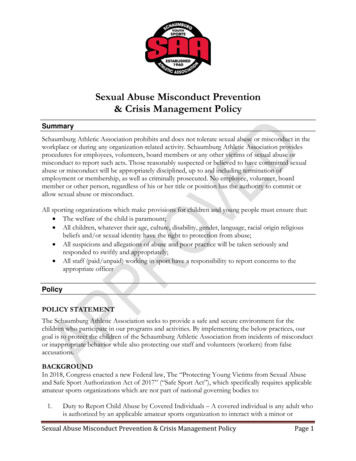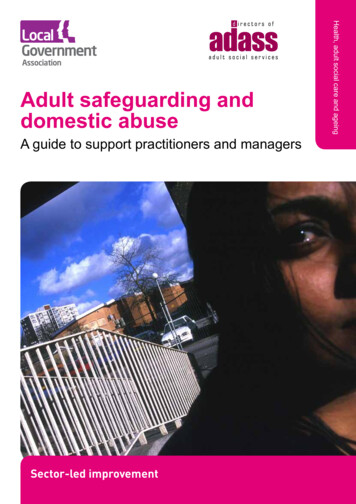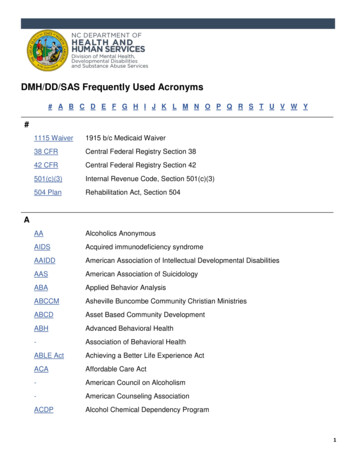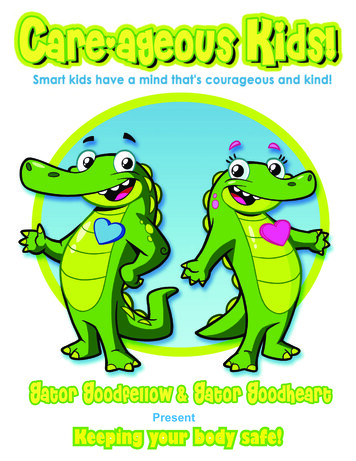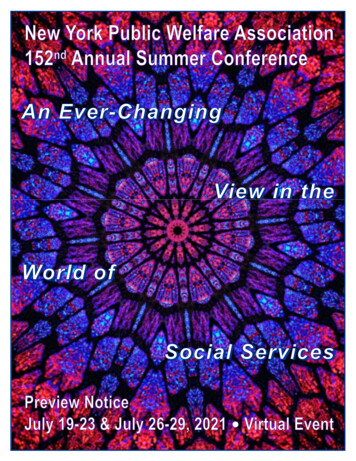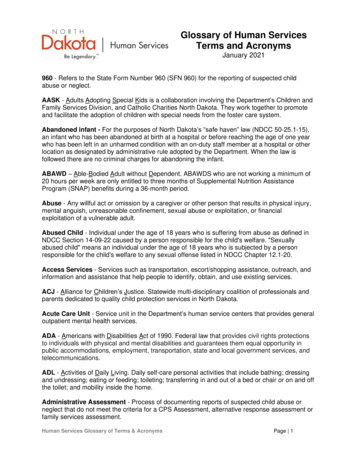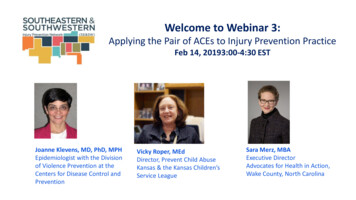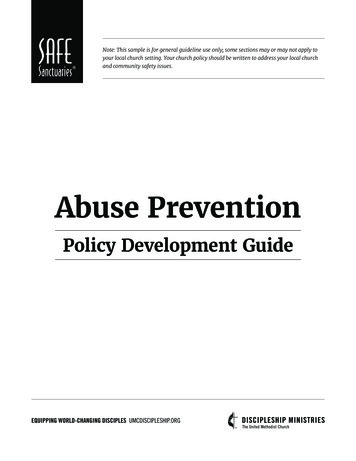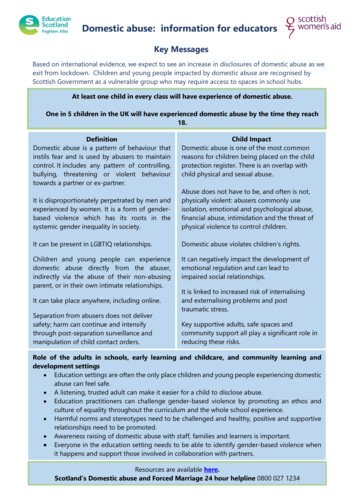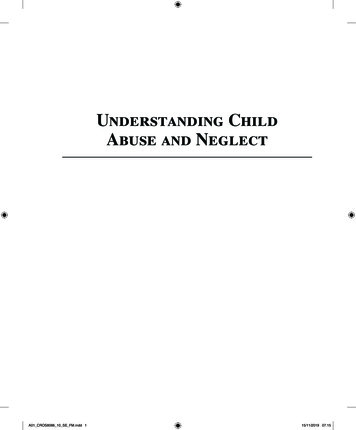
Transcription
Understanding ChildAbuse and NeglectA01 CROS8066 10 SE FM.indd 115/11/2019 07:15
A01 CROS8066 10 SE FM.indd 215/11/2019 07:15
Te n t h E d i t i o nUnderstanding ChildAbuse and NeglectCynthia Crosson-TowerA01 CROS8066 10 SE FM.indd 315/11/2019 07:15
Please contact pport with any queries on this content.Copyright 2021, 2014, 2010 by Pearson Education, Inc. 221 River Street, Hoboken, NJ 07030. All Rights Reserved.Manufactured in the United States of America. This publication is protected by copyright, and permission should be obtained fromthe publisher prior to any prohibited reproduction, storage in a retrieval system, or transmission in any form or by any means,electronic, mechanical, photocopying, recording, or otherwise. For information regarding permissions, request forms, and theappropriate contacts within the Pearson Education Global Rights and Permissions department, please visit www.pearsoned.com/permissions/.Acknowledgments of third-party content appear on the appropriate page within the text.PEARSON, ALWAYS LEARNING, REVEL, and MYLAB are exclusive trademarks owned by Pearson Education, Inc. or itsaffiliates in the U.S. and/or other countries.Unless otherwise indicated herein, any third-party trademarks, logos, or icons that may appear in this work are the property of theirrespective owners, and any references to third-party trademarks, logos, icons, or other trade dress are for demonstrative or descriptivepurposes only. Such references are not intended to imply any sponsorship, endorsement, authorization, or promotion of Pearson’sproducts by the owners of such marks, or any relationship between the owner and Pearson Education, Inc., or its affiliates, authors,licensees, or distributors.Library of Congress Cataloging-in-Publication DataNames: Crosson-Tower, Cynthia, author.Title: Understanding child abuse and neglect / Cynthia Crosson-Tower.Description: Tenth edition. Hoboken, NJ : Pearson, [2021] Includesbibliographical references and index.Identifiers: LCCN 2019041748 (print) LCCN 2019041749 (ebook) ISBN 9780135168066 (paperback) ISBN 9780135170830 (ebook) ISBN 9780135170915 (ebook)Subjects: LCSH: Child abuse--United States. Abused children--Servicesfor--United States. Social work with children--United States.Classification: LCC HV6626.52 .T69 2021 (print) LCC HV6626.52 (ebook) DDC 362.760973--dc23LC record available at https://lccn.loc.gov/2019041748LC ebook record available at CodeISBN-10: 0-13-516806-6ISBN-13: 978-0-13-516806-6A01 CROS8066 10 SE FM.indd 415/11/2019 07:15
For Chay and Becky, who are demonstrating what good parenting can be,and to Ruby, my incredible granddaughter.A01 CROS8066 10 SE FM.indd 515/11/2019 07:15
A01 CROS8066 10 SE FM.indd 615/11/2019 07:15
PREFACEWe live in a culture that values comfort and a sense of well-being. Even in today’s difficult economy, the expectation is that, despite having to make some sacrifices, each citizen has the opportunity to achieve this sense of well-being. Yet, many members of our culture—our children—arebeing beaten, neglected, and sexually exploited in alarming numbers. Every 10 seconds, a childis being abused or neglected. Granted, child abuse and neglect have existed for centuries. Andalthough the incidence of child maltreatment actually decreased slightly for a few years, we inthe child welfare field have not seen the progress we hoped for. The fact remains that children arestill being abused—in some cases more seriously than ever.Why has child maltreatment become such a serious issue, with only limited success indecreasing its incidence? The answer may have several facets. We live in a more violent societythan ever before. We are barraged with violent images, both in the news and in our entertainment.Crime statistics attest to the impact of this desensitization, as does the intensity and seriousnessof the abuse perpetrated against children. Finally, the rise in drug abuse has impacted families andleft its mark on their children. All of these factors require us to be even more diligent in our worktoward stemming the tide of child maltreatment.The question is, how do we do so? Is the answer affected by the fact that the child protection system, set up to safeguard the lives of the children at risk for maltreatment, is not achievingits goal? As a former protective services worker, I recognize that individual professionals withinprotective services are often dedicated and well meaning, but the system as a whole is still notadequately protecting children, nor are these services often our fiscal priority.What can be done to reverse the disturbing fact of child maltreatment? And how can society,and more specifically the child welfare system, better protect the children at risk?These questions can be addressed from several vantage points. We look not only to raisesocietal awareness and increase research into causes of abuse and neglect, but also to changesocial policy, triage the child welfare system, and provide better training for protective workers,not only in the skills important to do their job but in culturally sensitive ways to approach a varietyof people from many different backgrounds.After over 35 years of teaching courses on child abuse and neglect, many years in the childprotection system, and over 45 years in the field of social services, I have written this book,now in the tenth edition, to prepare future and even current professionals to better interveneand treat the children and families at risk. This book draws on my years of practice to present an all-encompassing view of maltreatment, in its various guises, from symptoms of abuseand neglect to motivations of those who abuse and neglect children, as well as how the socialservices system intervenes. The questions asked of me by students, social service workers, andtrainees have helped to shape the direction of the book. The responses from faculty reviewerswho teach courses in child welfare have further fine-tuned what is presented here. My experiences not only as a protective social worker but also as a therapist treating victims, families,and perpetrators and now as a clergywoman have helped to provide ideas for the illustrationsand examples.viiA01 CROS8066 10 SE FM.indd 715/11/2019 07:15
viiiPrefaceNEW TO THIS EDITIONThere are substantial revisions and updated materials throughout the text. Below are a few of themost exciting changes:1. The text has been reorganized into 17 chapters so that no one chapter is too overwhelming in length.2. Each chapter ends with case studies or other material that invites the student to demonstrate learning of the chapter material through applying it to a case situation.3. Chapter 2 on families includes a look at the diverse populations of the twenty-first century,including refugee and newly immigrated families; families with lesbian, gay, bisexual, andtransgender members; and grandparent families. More attention is given to the importanceof understanding cultural variations when working with clients.4. Chapter 3 on child development now includes material about the developing brain andhow it is impacted by maltreatment.5. This thread of neuroscience continues throughout the text as the chapters explaining thetypes of abuse or neglect (Chapters 4, 5, 6, and 7) discuss how the brain is affected byeach particular form of child maltreatment.6. Chapter 8 looks more closely at child sex trafficking.7. Chapter 10 now covers the full range of intervention, from reporting through casemanagement.8. The old Chapter 10 has been separated into two chapters—Chapters 10 and 11—so thatmore attention could be given in Chapter 11 to the role of other professionals with emphasis on collaboration.9. The functions of initial intervention and case management are more clearly defined, andthere is a clearer explanation of what constitutes treatment in protective situations.10. The day in the life of a child protection worker in Chapter 17 has been rewritten by aprotective services supervisor working in child protection to reflect today’s practices.11. The references have been moved to the end of each chapter for easier access.12. Learning objectives are provided in each chapter to guide the student in reading thematerial.PLAN FOR THE TEXTChapter 1 builds a framework for the discussion of abuse and neglect by tracing the historyof child maltreatment from biblical times to the present. Chapter 2 considers the responsibilities of families, including a look at different ethnic and functional families, and discusseswhat rights society accords families and children. Maltreatment and the developing childare the focus of Chapter 3, which examines the effects of abusive and neglectful behavioron children’s brain development and developmental progress, or lack of progress, through thestages of growth.Chapters 4–9 outline the symptoms of neglect, physical abuse, sexual abuse, and emotional/psychological abuse, and they examine the needs and motivations of abusive and neglectful parents. Chapter 7 looks more closely at the incidence of incest, or sexual abuse within the familysetting. Since sexual abuse can also be perpetrated by those outside the home, Chapter 8 considersextrafamilial abuse, including a discussion of child pornography, abuse on the Internet, and childsex trafficking. Chapter 9 looks at the psychological abuse of children.A01 CROS8066 10 SE FM.indd 815/11/2019 07:15
PrefaceixChapters 10, 11, and 12 focus on how to combat the problem of abuse. Chapter 10 discussesthe intervention process—from the report through the investigation and case management—andhighlights such important elements of protective work as home visiting and investigative interviewing. Chapter 11 outlines the roles of other professionals and describes the activities of casemanagement in more detail, explaining the difference between case management and treatment.The court system and how it might be called on to address abuse, neglect, and sexual abuse areconsidered in Chapter 12, distinguishing between intervention through the juvenile court processand prosecution through the criminal court system.Chapters 13 and 14 outline the models of treatment available for abused and neglectedchildren and their families. Therapy approaches for each type of maltreatment are consideredseparately. Chapter 15 discusses foster care—by both family members (kinship care) and familyfoster homes—and explains how foster home placement is a therapeutic tool.Following this examination of intervention, Chapter 16 provides a view of the experiencesof adults who, as children, never reported abuse. The treatment available for these survivors isdiscussed.The experience of working in child protection is the subject of Chapter 17—from a typicalday in the life of a protective social worker today and the challenges of the work, to the part thatworkers must play in prevention and in planning for the future.In this tenth edition, I have continued to highlight more current research. The majority ofthe most recent research is now coming from Great Britain, Australia, and Europe as these regionsmeet the challenges of responding to child abuse and neglect. I have used these sources when theinformation appeared to be applicable to the United States. I have also continued to use classicwritings in the field as well as a few more recent, albeit smaller, studies.In response to reviewer requests, this edition has been reorganized into 17 chapters so thatno one chapter is too long. The information on intervention and case management is now contained in Chapters 10 and 11. A new Chapter 17 focuses on the important aspects of child protection work, including the need for social workers not only to pay attention to prevention but alsoto use their expertise to anticipate the best solutions for the future.Attention to military families continues in this tenth edition. Additional information on braindevelopment and the impact of maltreatment on the brain has been added. The topics of child sextrafficking and an expanded section on kinship care reflect the trends in child protection today.Understanding Child Abuse and Neglect can be used as a text for undergraduate as well asgraduate courses in social work, human services, psychology, and sociology, or in counseling,family studies, and education programs.ACKNOWLEDGMENTSMany people have contributed directly or indirectly to the writing of this book. My thanks go firstto my family—especially to my husband, Jim; my sons, Chay and Andrew; and my daughter-inlaw, Becky. They continue to encourage me. In addition, my granddaughter, Ruby Louise, hasreminded me of the promise of childhood and how it must be protected.I have learned a great deal over the years from my students, both in the behavioral sciencesand in theology, whose interest, enthusiasm, and inquiries have done much to stimulate thisendeavor. As graduates, they have continued their support, often as close friends. Thank you toKim Copp, who was good enough to help me update Chapter 17’s “A Day in the Life of Today’sProtective Worker” to reflect today’s world in protective services.A01 CROS8066 10 SE FM.indd 915/11/2019 07:15
xPrefaceI thank the following reviewers for their helpful comments: Jennifer Jorgenson, NorthernKentucky University; Judy Krysik, Arizona State University; Piljoo Kang, Toccoa Falls College;and Andrea Rashtian, California State University Northridge.I also thank Rebecca Fox-Gieg, my Pearson editor, who has been a wonderful addition toPearson. Her compassion and understanding as well as her flexibility and assistance have madethis edition possible. Much appreciation also to Pam Bennett, who has been great to work with,and to all the other dedicated and hard-working folks who labored to make this edition possible.Cynthia Crosson-TowerProfessor Emerita Fitchburg State University and Harvest Counseling and ConsultationThis text is available in a variety of formats—digital and print.To learn more about our programs, pricing options, and customization,visit www.pearsonhighered.com.A01 CROS8066 10 SE FM.indd 1015/11/2019 07:15
BRIEF CONTENTSChapter 1The Maltreatment of Children Then and Now1Chapter 2The Family: Roles, Responsibilities, and Rights26Chapter 3Trauma and the Developing ChildChapter 4The Neglect of ChildrenChapter 5The Physical Abuse of ChildrenChapter 6The Sexual Abuse of ChildrenChapter 7Intrafamilial AbuseChapter 8Extrafamilial Sexual Abuse, Misuse,and Exploitation 205Chapter 9Psychological Maltreatment of Children5581115145175239Chapter 10 Intervention: Reporting, Investigation,and Assessment 253Chapter 11 Collaborative Intervention and Case ManagementChapter 12 The Legal Response to Child Abuse and Neglect291309Chapter 13 Case Management and Treatment of Physical Abuseand Neglect 331Chapter 14 Treatment of Sexual Abuse360Chapter 15 Foster Care for Abused and Neglected ChildrenChapter 16 Adults Abused as Children404Chapter 17 Working in Child Protection and PreventionIndex388438477xiA01 CROS8066 10 SE FM.indd 1115/11/2019 07:15
A01 CROS8066 10 SE FM.indd 1215/11/2019 07:15
CONTENTSPrefaceviiChapter 1 The Maltreatment of Children Then and Now1Early Views of Children 1Issues of Life and Death 1Issues of Dependence 2Issues of Discipline 3Issues of Sexual Exploitation 4Concern Over Child Labor Brings Efforts Toward Change 6The Settlement House Movement 6Efforts for African American Children 7The Plight of Native American Children 8Recent History of Helping Abused and Neglected Children 8The Case That Changed History 9Impact of the White House Conferences 10Influence of the Social Security Act 10Advances in the 1940s–1960s 11The ‘60s and ‘70s: Further Efforts on Behalf of Children 12Professional Awareness and Response to the Movement to ProtectChildren and Families 14Emerging Influences on Child Protection 15Adverse Childhood Experiences (ACE) Study 15Child Maltreatment Through the Lens of Trauma16The Role of Child Protection Services 18Child Protection Emerging 18Child Rearing, Maltreatment, and Public Opinion 20Child Protection Today 20Summary 21Applying the Concepts of This Chapter 23References 23Chapter 2 The Family: Roles, Responsibilities, and Rights26The Definition and Function of the Family 26The Twenty-First Century Family 28The Family as a System 29Subsystems and Boundaries 30Roles 30Communication 31xiiiA01 CROS8066 10 SE FM.indd 1315/11/2019 07:15
xivContentsBonding and AttachmentRituals 3332Cultural Family Systems 33African American Families 34Hispanic American Families 36Asian and Pacific Islander Families 38Native American Families 40Arab American and Middle Eastern Families 41Additional Types of Family Systems 42Grandparents Raising Grandchildren 42Lesbian, Gay, Bisexual, and Transgender Families 43Military Families 44The Challenges of Developing Cultural Awareness 46Family Problems and Dysfunction 46The Family and Child Maltreatment 47Parents’ Rights 48Children’s Rights 48Impact on the Child Protection Movement 50Summary 50Applying the Concepts of This Chapter 51References 52Chapter 3 Trauma and the Developing Child55Understanding Trauma 55How Trauma Impacts the Brain 55Degrees and Types of Trauma 58Influences on Development 59Early Brain Development 59Attachment and the Impact of TraumaThe Impact of Parenting 6060Development Through the Stages 62Pregnancy and BirthBirth to 1 Year 641 to 4 Years 684 to 8 Years 718 to 12 Years 72Adolescence 7362Resilience and the Adaptable Brain 74Developing Resilience 75The Adaptable Brain and Maltreatment 76Summary 76Applying the Concepts of This Chapter 78References 79A01 CROS8066 10 SE FM.indd 1415/11/2019 07:15
ContentsChapter 4 The Neglect of Childrenxv81The Neglect of the Concept of Neglect 81Definition and Impact of Neglect 82The Measurement of Neglect 85Risk Factors for Neglect 89Environmental FactorsEcological Factors 90Parenting Factors 9189Problems in Intervention 91Neglected Children 92Symptoms and Effects of Neglect92Neglectful Parents 96Early Efforts to Explain the Behavior of Neglectful Parents 98Parents Who Neglect Children 99Substance-Abusing Families 106Domestic Violence and Neglect 108Plight of the Parent and the Social Worker 108Summary 109Applying the Concepts of This Chapter 110References 111Chapter 5 The Physical Abuse of Children115Defining Physical Child Abuse 115Causes of Physical Abuse 117Interactional Variables 117Environmental/Life Stress Variables 119Social/Cultural/Economic Variables 119Risk Assessment and Physical Abuse 119Child Risk and Protective Factors 120Parental Risk and Protective Factors 121Family System Risk and Protective Factors 121Symptoms of Physical Abuse 122Physical Symptoms 122Behavioral Indicators of Abuse 126Parents Who Abuse 130Parents’ Unlearned Tasks from Childhood 130Fictitious Disorder 132Abusive Parents and Adolescents 133The Impact of War on Family Violence 135Assessing Parents Who Physically Abuse Children 136Intimate Partner Violence and Other Abuse Within the Family 136Interpartner Family ViolenceAbuse by Siblings 137A01 CROS8066 10 SE FM.indd 1513615/11/2019 07:15
xviContentsSummary 139Applying the Concepts of This Chapter 139References 141Chapter 6 The Sexual Abuse of Children145The Emergence of Child Sexual Abuse 145Child Protection Movement and the Feminist Movement 146Definition of Child Sexual Abuse 147Types of Sexual Abuse 148Intrafamilial Abuse 148Extrafamilial Abuse 148Progression of Sexual Abuse 149Engagement Phase 150Sexual Interaction and Secrecy Phases 151Disclosure Phase 151Suppression Phase 151Incidence of Sexual Abuse 152Early Studies of Child Sex Abuse 152Recent Reports 153Influence of Reporting on Statistics 154False Allegations Movement 154Child Sexual Abuse as Trauma 155Degree of Trauma155Profile of the Abused Child 156Children at Risk 157Female Victims 158Male Victims 158Profile of the Perpetrator 159Multifactor Theories 160Single-Factor Theories 163Process Models 163Which People Become Perpetrators? 164Female Abusers 165Juvenile Sexual Offenders 167Summary 169Applying the Concepts of This Chapter 169References 170Chapter 7 Intrafamilial Abuse175The Incest Taboo 175Reasons for Taboo 175Legal and Social Prohibition 177A01 CROS8066 10 SE FM.indd 1615/11/2019 07:15
ContentsxviiIntrafamilial Abuse as a Problem Today 178Societal Contributions to Incest 178Father–Daughter Incest 179Family Patterns 179Profiles of the Family181Father–Son Incest 187Family Dynamics 187Effects of Father–Son Incest 188Mother–Daughter Incest 189Family Dynamics 189Effects of Mother–Daughter Incest 190Mother–Son Incest 191Family Dynamics 191Effects of Mother–Son Incest 193Brother–Sister Incest 193Family Dynamics 195Effects of Brother–Sister Incest196Same-Sex Sibling Incest 196Incest with Uncles, Grandfathers, and Cousins 197Why Incest Stops 199Summary 200Applying the Concepts of This Chapter 201References 202Chapter 8 Extrafamilial Sexual Abuse, Misuse,and Exploitation 205Dynamics and Characteristics of Sexual Abuse Outsideof the Family 205Pedophilia 209Pederasty 211Sexual Abuse by Clergy 213Motivation of Perpetrators 214Crisis in the Catholic Church 214Impact on Victims 216Addressing Clerical Perpetrators 217Sexual Abuse in Day Care Settings 218Types of Day Care Abuse 219Reactions and Resulting Changes 219Child Sex Trafficking, Child Pornography, and the Internet 219Child Pornography 220Child Sex Trafficking 226A01 CROS8066 10 SE FM.indd 1715/11/2019 07:15
xviiiContentsSummary 232Applying the Concepts of This Chapter 233References 235Chapter 9 Psychological Maltreatment of Children239Psychological Maltreatment Defined 239The Roots of Psychological Maltreatment 242Characteristics of the Psychologically Maltreated Child 243Psychological Abuse and the Developing Brain 244Family Dynamics in Psychological Abuse 245Difficulty in Detecting and Treating Psychological Abuse246Ritualistic Abuse 246Summary 248Applying the Concepts of This Chapter 249References 251Chapter 10 Intervention: Reporting, Investigation,and Assessment 253Culturally Sensitive Intervention 253Cultural Competence Defined 253Putting Cultural Competence into Practice 254Using Translators 257Understanding the Intervention Process 258Reporting 258Child Protection Teams 261Investigation and Assessment 262Family Reactions 262Home Visiting 264Assessing Risk and Protective Factors 266Children 267Caregivers 271Perpetrators 271Incidence and Environment 271Exploring Causes and Services 271Handling Emergencies 272Interviewing for Assessment 272Interviewing Adults 273Interviewing Children 278Custody of the Children 285Summary 286Applying the Concepts of This Chapter 287References 288A01 CROS8066 10 SE FM.indd 1815/11/2019 07:15
ContentsxixChapter 11 Collaborative Intervention and CaseManagement 291A Collaborative Approach 291Child Advocacy Centers 291Other Professionals Involved in the Intervention Process 293The Medical Team 293The Legal Team 297The Educational Team 299The Mental Health Team 303Clergy and Church Staff 303The Community 304Toward a Total Team Approach 304Case Management and Planning 304Summary 305Applying the Concepts of This Chapter 306References 307Chapter 12 The Legal Response to Child Abuse and Neglect309Legal Intervention 309The Legal Rights of Parents and Children 310Types of Court Intervention 311Juvenile Court 312Criminal Court 323The Impact of Court on Children 325Sex Offender Registration 326The Media and the Court 327Summary 327Applying the Concepts of This Chapter 328References 329Chapter 13 Case Management and Treatment of Physical Abuseand Neglect 331Case Management 332From Case Management to Treatment 334Providing Treatment 334Client Resistance 336Client Response 337Eligibility Criteria 338Limited Community Resources 339Who Provides Treatment? 339Duration of Treatment 340A01 CROS8066 10 SE FM.indd 1915/11/2019 07:15
xxContentsTreatment of Neglectful Families 340In-Home Family-Centered Services 341Shared Family Care 345Treatment of Physically Abusive Families 345Treatment of the Abused Child 347Treatment of the Parents 352Treatment of the Siblings 356Summary 356Applying the Concepts of This Chapter 357References 357Chapter 14 Treatment of Sexual Abuse360Issues Surrounding Treatment 360Assumptions About the Treatment of the SexuallyAbusive Family 361Treatment Models 363Child Sexual Abuse Treatment Program363Considerations in Treatment 363Issues Addressed in Family Treatment 363Phases of Intervention and Treatment in Sexually Abusive Families 364Treatment of Specific Family Members 367The Child and Adolescent 367The Mother or Non-abusing Parent 371The Perpetrator 373Treatment of Juvenile Offenders 380Is Treatment Effective? 380Preservation of Incestuous Families 381Parents of Children Abused Outside the Home 381Summary 383Applying the Concepts of This Chapter 384References 385Chapter 15 Foster Care for Abused and Neglected Children388Alternatives to Foster Care 388Rationale for Foster Care 389The Emergence of Formalized Kinship Care 390Kinship Foster Care Today 391A Look at Foster Care Today 393Therapeutic Potential in Foster Care 394The Role and Importance of the Birth Parents 395A01 CROS8066 10 SE FM.indd 2015/11/2019 07:15
ContentsxxiThe Role of Foster Parents 395Problems with Foster Care 397Other Placement for Abused or Neglected Children 398Residential Treatment 398Adoptive Placement 399Summary 400Applying the Concepts of This Chapter 401References 402Chapter 16 Adults Abused as Children404Society’s Misconceptions 404Reasons for Adults’ Disclosure 406Relationships 406Pressures of Adulthood 407Loss, Depression, or Trauma 408Residual Effects of Child Abuse and Neglect 408Effects from the Neglecting Family 409Trust 409Anger 410Relational Imbalances 411Low Self-Esteem 411Impaired Social Skills 412Substance Abuse and Criminality 413Physical Problems 413Effects from the Physically Abusing Family 414Trust 414Anger 414Relational Imbalances 415Low Self-Esteem 415Coping Skills 416Physical Implications 416Long-Term Effects of Domestic Violence 416Effects From a Sexually Abusing Family 417Betrayal 418Traumatic Sexualization 418Stigmatization and Self-EsteemPowerlessness 421Anger 422Relational Imbalances 423Multiple Victimization 424419Effects From Extrafamilial Abuse 426A01 CROS8066 10 SE FM.indd 2115/11/2019 07:15
xxiiContentsA Word About Resiliency 427Treatment of Adults Who Were Abused as Children 427Repressed Memories 428Individual Therapy 428Group Therapy 429Self-Help Groups 431Writers’ Groups 431Legal Actions 431Therapists’ Responses to Working with Survivors 432Summary 432Applying the Concepts of This Chapter 433References 434Chapter 17 Working in Child Protection and Prevention438A Day in the Life of Today’s Protective Worker 438Skills and Qualifications Needed for Child Protection 441Knowledge 441Authority and Sanction 442Ethics 442Professionalism 443Ethnic Competence 443Personal Traits 444Effectively Juggling Tasks and ResponsibilitiesDealing with Frustrations and Pressures 445444Facing the Challenges of Working in Child Protection 447Working in a Bureaucracy 448Impact on Social Workers 448The Importance of Training and Supervision 449The Importance of Self-Care in Child Protective Services450An Eye Toward Prevention 450The Goals of Prevention Efforts451Prevention Efforts in Schools 452Life Skills Training 452Preparation for Parenthood 453Self-Protection Training 455Educational Services for the CommunityHelp for At-Risk Families 456456Prevention Efforts with Families 456Evaluating Home Visitation Programs 457Parent/Child Screening and Prevention 458Culturally Sensitive Prevention 460A01 CROS8066 10 SE FM.indd 2215/11/2019 07:15
ContentsxxiiiEffective Prevention 460Working Toward a Better Tomorrow 461Rethinking Child Protection 463Creating a Unified Response 464Looking Within, Between, and Beyond Agencies 465Beyond Child Protection: The Need for Societal Changes 467Reversing the Trend Toward Socially Impoverished FamiliesSupporting Parenting 468Realigning Societal Values 469468What Does the Future Hold? 470Research Needs 470Summary 471Applying the Concepts of This Chapter 473References 474Index477A01 CROS8066 10 SE FM.indd 2315/11/2019 07:15
A01 CROS8066 10 SE FM.indd 2415/11/2019 07:15
After over 35 years of teaching courses on child abuse and neglect, many years in the child protection system, and over 45 years in the field of social services, I have written this book, now in the tenth edition, to prepare

